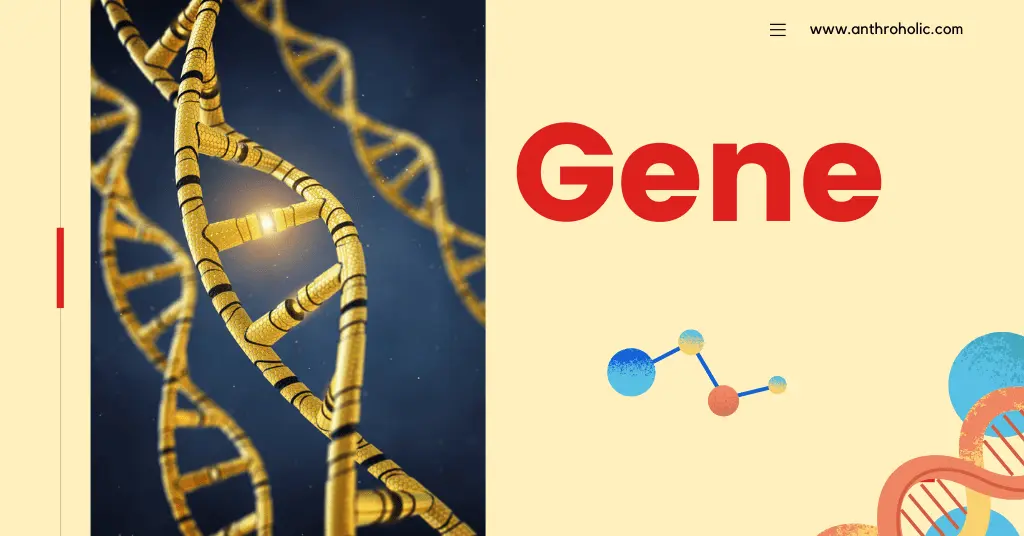AI Answer Evaluation Platform Live Now. Try Free Answer Evaluation Now
Gene
The biological blueprint that shapes who we are, and the intricate dance between nature and nurture, has long fascinated scientists and anthropologists alike. At the heart of this complex interplay lies the gene, a fundamental unit of heredity and the building block of life.

The Molecular Basics of Genes
A. Structure and Composition
Genes are segments of DNA (deoxyribonucleic acid), a molecule composed of two long, intertwined chains made up of nucleotides. Each nucleotide consists of three components: a phosphate group, a sugar molecule (deoxyribose), and one of four nitrogenous bases – adenine (A), guanine (G), cytosine (C), and thymine (T) [1]. The sequence of these bases within a gene provides the blueprint for creating proteins, which perform a vast array of functions within our cells and ultimately shape our traits and characteristics.
B. The Central Dogma of Molecular Biology
The process by which genetic information encoded within DNA is transcribed into RNA (ribonucleic acid) and subsequently translated into proteins is known as the Central Dogma of Molecular Biology [3]. This process occurs in two stages: transcription and translation. During transcription, an enzyme called RNA polymerase synthesizes a single-stranded molecule of RNA, using the DNA sequence as a template. The newly formed RNA then serves as a template for the assembly of amino acids into proteins during translation, which takes place in ribosomes.
C. Genetic Code
The genetic code is the set of rules by which the sequence of nucleotide bases in a gene is translated into the sequence of amino acids in a protein. The code is composed of triplets of bases called codons, each of which specifies a particular amino acid or signals the start or stop of translation [13]. The genetic code is considered universal because it is shared by nearly all organisms on Earth, underscoring the common ancestry of life.
| Codon | Amino Acid | Codon | Amino Acid |
|---|---|---|---|
| UUU | Phenylalanine | CUU | Leucine |
| UUC | Phenylalanine | CUC | Leucine |
| UUA | Leucine | CUA | Leucine |
| UUG | Leucine | CUG | Leucine |
Human Genetic Variation and Anthropology
A. Types of Genetic Variation
- Single Nucleotide Polymorphisms (SNPs): SNPs are the most common type of genetic variation, occurring when a single nucleotide in a DNA sequence is altered [12]. SNPs can have various consequences, from causing no observable change to leading to significant alterations in protein function.
- Copy Number Variations (CNVs): CNVs are large-scale alterations in the genome involving the duplication or deletion of DNA segments [4]. CNVs can have significant effects on gene dosage and are associated with various human diseases and phenotypic traits.
B. The Role of Genetic Variation in Human Evolution
Genetic variation is essential for the process of evolution, as it provides the raw material for natural selection to act upon. In humans, genetic variation has played a pivotal role in shaping our species’ history, adaptation, and diversification.
- Population Genetics and Human Evolution: Population genetics is the study of genetic variation within and between populations, which helps us understand the processes driving human evolution [9]. Population geneticists examine allele frequencies, migration patterns, and the effects of natural selection and genetic drift to reconstruct the history of human populations and infer patterns of human evolution.
- Human Adaptation: Genetic variation has facilitated human adaptation to different environments, enabling our species to colonize diverse habitats across the globe. For example, genetic adaptations to high-altitude environments have been found in populations living in the Andes, the Tibetan Plateau, and the Ethiopian Highlands [2].
- Human Diversity and the Concept of Race: While genetic variation contributes to the rich tapestry of human diversity, it is essential to recognize that the concept of race has no firm biological basis. Most genetic variation exists within populations, rather than between them, and genetic differences do not align with traditional racial classifications [7]. Consequently, the concept of race should be understood as a social construct, rather than a biological reality.
The Genomic Era: Implications for Biology and Anthropology
A. Genomic Technologies and Their Impact on Research
The advent of genomic technologies, such as next-generation sequencing and genome-wide association studies (GWAS), has revolutionized our understanding of human biology and anthropology. These technologies have enabled researchers to identify genes associated with various traits and diseases, as well as explore the genetic basis of human evolution and migration [5].
B. Ethical Considerations in Genomic Research
With great advancements come great responsibilities, and the genomic era has raised several ethical concerns. These include issues related to privacy, informed consent, and the potential for genetic discrimination [8]. It is crucial to address these concerns in order to ensure that the benefits of genomic research are realized while minimizing potential harms.
Conclusion
Genes serve as the blueprint for our biological and anthropological heritage, providing the foundation for our understanding of human biology and evolution. By unraveling the intricate world of genes and examining the role they play in human variation and evolution, we gain valuable insights into our shared history and the factors that have shaped our species. As we continue to explore the genomic landscape, we must strive to balance the incredible potential of these technologies with the ethical considerations they raise, ensuring that our newfound knowledge is harnessed for the betterment of all.
References
[1] Alberts, B., Johnson, A., Lewis, J., Raff, M., Roberts, K., & Walter, P. (2014). Molecular biology of the cell (6th ed.). Garland Science.
[2] Bigham, A., Bauchet, M., Pinto, D., Mao, X., Akey, J. M., Mei, R., Scherer, S. W., Julian, C. G., Wilson, M. J., López Herráez, D., Brutsaert, T., Parra, E. J., Moore, L. G., & Shriver, M. D. (2010). Identifying signatures of natural selection in Tibetan and Andean populations using dense genome scan data. PLoS Genetics, 6(9), e1001116.
[3] Crick, F. (1970). Central dogma of molecular biology. Nature, 227(5258), 561-563.
[4] Feuk, L., Carson, A. R., & Scherer, S. W. (2006). Structural variation in the human genome. Nature Reviews Genetics, 7(2), 85-97.
[5] Gibson, G., & Dessimoz, C. (2011). How to measure and test phylogenetic signal. Methods in Ecology and Evolution, 2(4), 331-344.
[6] Huerta-Sánchez, E., Jin, X., Asan, Bianba, Z., Peter, B. M., Vinckenbosch, N., Liang, Y., Yi, X., He, M., Somel, M., Ni, P., Wang, B., Ou, X., Huasang, Luosang, J., Cuo, Z. X. P., Li, K., Gao, G., Yin, Y., Wang, W., … Nielsen, R. (2014). Altitude adaptation in Tibetans caused by introgression of Denisovan-like DNA. Nature, 512(7513), 194-197.
[7] Jorde, L. B., & Wooding, S. P. (2004). Genetic variation, classification and ‘race’. Nature Genetics, 36(11 Suppl), S28-S33.
[8] Knoppers, B. M., & Chadwick, R. (2013). Human genetic research: emerging trends in ethics. Nature Reviews Genetics, 14(1), 61-65.
[9] Nielsen, R. (2005). Molecular signatures of natural selection. Annual Review of Genetics, 39, 197-218.
[10] Nielsen, R., Akey, J. M., Jakobsson, M., Pritchard, J. K., Tishkoff, S., & Willerslev, E. (2017). Tracing the peopling of the world through genomics. Nature, 541(7637), 302-310.
[11] Scheinfeldt, L. B., Soi, S., Thompson, S., Ranciaro, A., Woldemeskel, D., Beggs, W., Lambert, C., Jarvis, J. P., Abate, D., Belay, G., Tishkoff, S. A., & Williams, S. M. (2012). Genetic adaptation to high altitude in the Ethiopian highlands. Genome Biology, 13(1), R1.
[12] Visscher, P. M., Wray, N. R., Zhang, Q., Sklar, P., McCarthy, M. I., Brown, M. A., & Yang, J. (2017). 10 years of GWAS discovery: biology, function, and translation. The American Journal of Human Genetics, 101(1), 5-22.
[13] Watson, J. D., Baker, T. A., Bell, S. P., Gann, A., Levine, M., & Losick, R. (2013). Molecular biology of the gene (7th ed.). Pearson.



